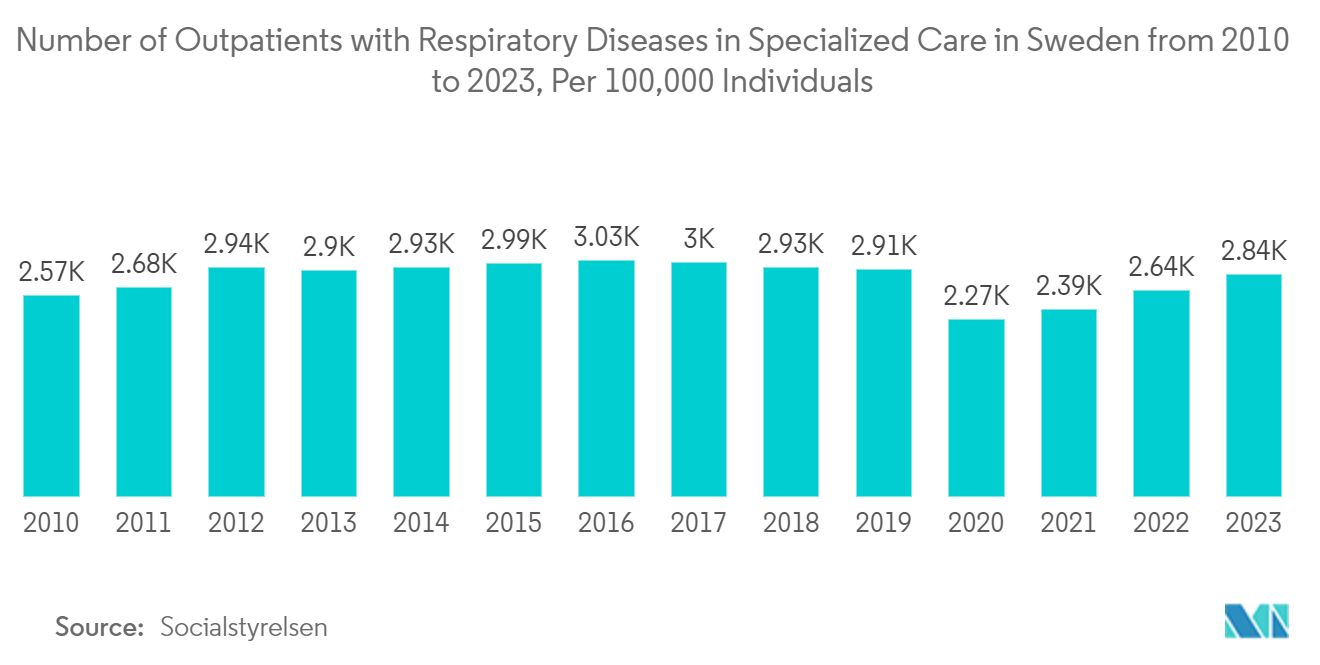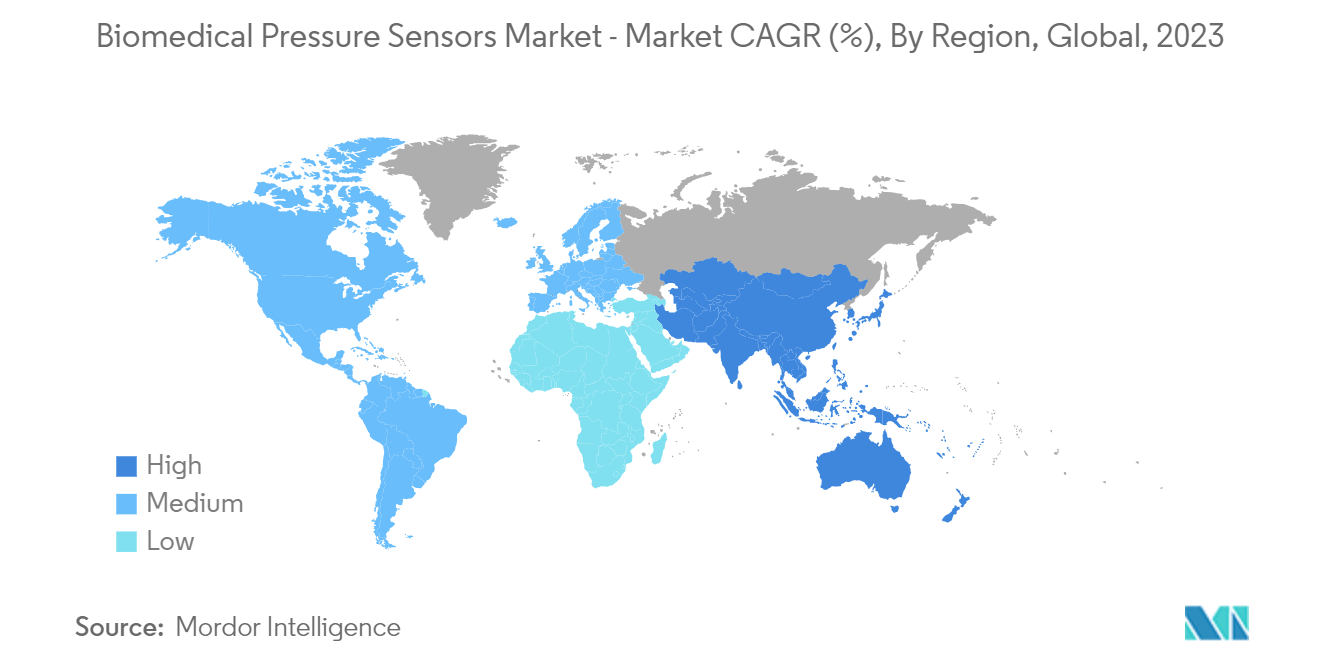Market Trends of Biomedical Pressure Sensors Industry
Therapeutic Applications to Witness Major Growth
- The therapeutic segment is expected to drive the market's growth significantly over the coming period, owing to the increasing adoption of pressure sensors. Various therapeutic devices, like chest physiotherapy machines and nebulizers, incorporate pressure sensors. Nebulizers utilize compressed air to produce a medication mist for patients to inhale. The pressure sensor monitors the flow rate of compressed air and makes adjustments as needed to guarantee precise drug administration. These devices are specifically engineered to manage chronic obstructive pulmonary disease (COPD), asthma, cystic fibrosis, and other respiratory conditions.
- Chest physiotherapy machines utilize high-pressure air jets to help loosen and remove mucus from the lungs. These devices are equipped with a pressure sensor to monitor and adjust the pressure of the air jets for maximum therapeutic benefit. Additionally, a sensitive and flexible pressure sensor is employed to detect pressure changes, and an efficient ASP system is utilized to extract heart rate data from the signal. The accuracy of this heart rate sensor has been confirmed through testing on multiple subjects, demonstrating its high precision.
- Respiratory physiotherapy equipment provides numerous benefits, including the ability for independent use, full treatment control, and user-friendly operations, which ultimately enhance patients’ adherence to daily treatment regimens and consequently boost the demand for such equipment. These pressure transducers offer an indirect assessment of airflow through the detection of pressure fluctuations, exhibiting a strong response to airflow patterns and the ability to identify airflow restrictions. The rising investments in respiratory therapeutic equipment are anticipated to propel market prospects.
- According to the World Health Organization (WHO), asthma and chronic obstructive pulmonary disease (COPD) are the most prevalent chronic respiratory diseases. These two conditions collectively result in nearly 4 million deaths annually, with approximately half a billion individuals living with them. Additionally, data from Socialstyrelsen indicates that the number of respiratory disease patients receiving outpatient specialized care in Sweden increased from 2,644.1 in 2022 to 2,843 in 2023. These significant developments are anticipated to drive increased investments in respiratory therapeutic equipment, consequently boosting the demand for pressure sensors within this segment.
- Additionally, the rising need for advanced respiratory drug delivery devices and the growing acceptance of these devices by patients will drive the demand for biomedical pressure sensors in therapeutic settings over the forecast period. The surge in respiratory conditions like asthma and COPD is fueling the demand for therapeutic devices, contributing to market expansion.

North America Expected to Register Significant Market Growth
- The primary share of the North American regional market can be credited to the expansion of application areas within the healthcare industry. Forecasts indicate that the increasing demand from emerging economies like the United States and Canada would significantly boost the need for biomedical pressure sensors. High growth is anticipated in the region throughout the forecast period, with key factors such as investments in medical infrastructure, research and innovation centers, government initiatives, and policies favoring the healthcare equipment and devices markets.
- The North American market is poised for growth due to factors such as the rising prevalence of chronic diseases and the increasing awareness of medical sensors among the populace. As per the National Health Council, by 2024, approximately 133 million Americans will be affected by chronic conditions, constituting over 40% of the country's population. The expansion of the biomedical pressure sensors market is linked to the growing focus on medical sensor development, improvements in healthcare infrastructure, and the early diagnosis of diseases.
- The inclusion of pressure sensors and transmitters in ventilators is necessary to regulate oxygen and air pressure, ensuring the safe and smooth operation of the device. These sensors are essential components in delivering respiratory support to patients undergoing COVID-19 treatment and other medical interventions. As a result, the increasing prevalence of chronic diseases and the growing aging population in the region are expected to drive technological advancements in the market.
- Additionally, the regional population’s increasing concerns over sleep apnea are boosting the need for pressure sensors. This disorder impacts numerous people, and devices like CPAP, BiPAP, and APAP depend on pressure sensors to supervise airflow and respiration. Positive Airway Pressure therapy is the most suggested remedy for obstructive sleep apnea, and different pressure sensors support its operations. Patients don a mask covering their nose and mouth, and a gentle air blower pushes air through the mask, opening up possibilities for the pressure sensors.
- According to data released by the American Medical Association in 2023, approximately 30 million people in the United States are affected by sleep apnea, with nearly 30% of the nation’s population showing signs of this disorder. The most common form was obstructive sleep apnea, affecting around 26% of individuals aged between 30 and 70. Therefore, healthcare professionals recommend the use of a CPAP device to reduce the occurrence of apnea episodes during sleep and decrease the likelihood of developing health issues like heart disease and stroke. Such factors are expected to create demand for pressure sensors.
- Government investments in the region are set to bolster the North American medical devices industry, creating favorable growth prospects for the market studied. The recent US legislation, specifically the Inflation Reduction ACT (IRA), will also play a role in influencing investments in the medical devices industry by introducing new guidelines for medical devices and other healthcare system components. Additionally, the increasing export and production values of medical devices from the United States to foreign countries like China, Japan, the Netherlands, and Germany are expected to drive market opportunities further.


